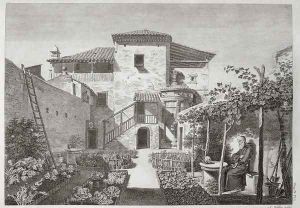after Stuart, James & Revett, Nicholas Paintings
James Stuart and Nicholas Revett were pioneering British archaeologists and architects famous for their seminal work in documenting Ancient Greek architecture. James Stuart, born in 1713, was an architect, archaeologist, and painter, who earned the nickname 'Athenian Stuart' for his contributions to the study of ancient Greek architecture. Nicholas Revett, born in 1721, was an architect and draftsman who partnered with Stuart in their notable travels to Greece.
The pair are best known for their work 'The Antiquities of Athens' published in several volumes starting in 1762, which was among the first accurate surveys of ancient Greek architecture. This influential publication helped to fuel the Neoclassical movement in Europe, particularly in Britain, where it had a profound impact on architecture and design for generations.
Stuart and Revett joined the Society of Dilettanti, a group of aristocrats and scholars that sponsored their expedition to Athens in 1751. Over several years, they meticulously measured and recorded the ruins of Greek antiquities, thus laying the groundwork for modern archaeological methods. Their dedication to precise observation and their use of detailed engravings to document their findings set new standards for archaeological and architectural studies.
James Stuart's contributions to architecture extended beyond his work on 'The Antiquities of Athens.' He also undertook various architectural projects in England, including the construction of buildings that featured Neoclassical elements inspired by his studies in Greece. He passed away in 1788.
Nicholas Revett's role in the partnership was less prominent in later years, but his initial collaboration with Stuart was crucial in the success of their Greek studies. Revett continued to work on the volumes of 'The Antiquities of Athens' after Stuart's death, ensuring their research was published and accessible to the public. Revett died in 1804.
Together, Stuart and Revett's meticulous work not only influenced architectural design but also contributed significantly to the historical understanding of ancient Greek architecture. Their legacy is one of scholarly dedication and the transformation of European architectural practice.
